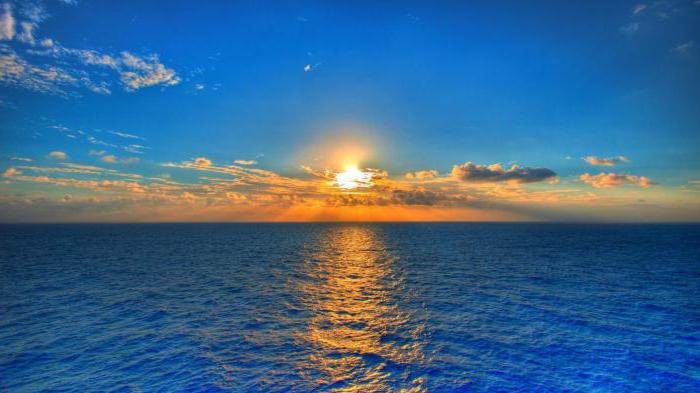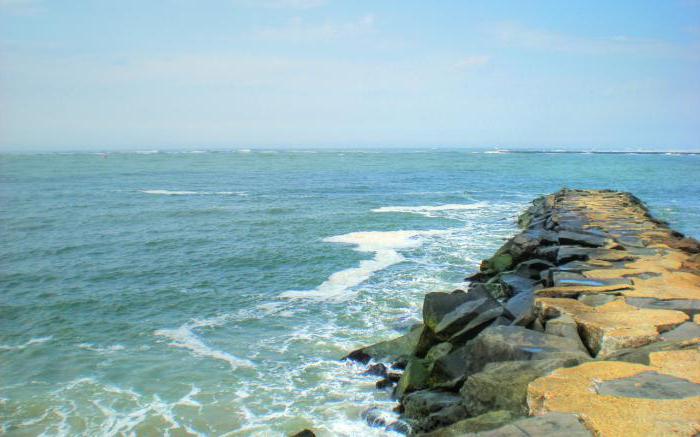Atlantic Ocean: geographical location, history and currents
Which is described below - a component of the oceans. This is one of the 4 major reservoirs of the planet. It ranks second in size, after the Pacific. The area of the smooth surface is 92 million square kilometers, it accounts for 25% of all the waters of the planet. From the east, the ocean is limited by Eurasia and Africa, from the north - by South and North America, in the south, the surface of the Atlantic reaches Antarctica. The average depth of the ocean is 3,500 km, and the maximum is 8,742 m (we are talking about the Puerto Rico Trench).
Atlantic Ocean - geographic location
The water area stretches from the northern part of the Earth to the southern region, crossing the subarctic and antarctic latitudes. At the extreme points, the ocean is quite wide and deep, while, reaching the equator, its length decreases to 2,900 km. Cape Agulhas is the border between the Atlantic and Indian Oceans, and Cape Gorny separates the territory described and the Pacific Ocean.
The origin of the name and the formation of the ocean
The description of the Atlantic Ocean should begin with its origin. It was formed as a result of the split of the ancient one from the broken parts of which modern continents arose. The name of the ocean is most often associated with Atlantis - an ancient mythical island that went under water thousands of years ago, presumably in this ocean. Another version of the name comes from (Africa).

Ocean floor
The coastline of the Atlantic is very indented, and the total number of rivers flowing into the ocean or seas is much greater than that of other large bodies of water. This is the feature that distinguishes this ocean from others. A unique bottom, which is very complex in terms of morphological factors, is inherent in such a water area as the Atlantic Ocean. The geographical position easily explains this fact. The Mid-Atlantic Ridge stretches along the entire length of the ocean, for 16,000 km. This is a seismically active zone with an unstable earth's crust. Sometimes underwater volcanoes of the ridge come to the surface. An example of such formations is the island of Iceland. A common occurrence for the bottom is hollows, the average depth of which is about 5-7 thousand meters. The deepest similar landform is North American, its height is 8,742 m. However, uplifts, ridges and hills are also not uncommon for the Atlantic Ocean. The bottom is covered with silts, mostly foraminifera. Closer to the continents, the silty surface gives way to terrigenous deposits: pebbles, gravel, and sand. In the deepest basins, the bottom is represented by red clays.
Climate
The variety of climatic conditions of the ocean determines its length from south to east. It captures all climatic zones - from cold Antarctic to hot equatorial. The temperature of the Atlantic Ocean is strongly influenced by the Arctic waters. Off the coast of North America, near Florida, the largest warm current, the Gulf Stream, is born. Its width is 75 km, the depth of the stream is 700 m. The Gulf Stream carries warm waters, the average temperature is 26 degrees above zero.

currents
Depending on the territory, the speed of the current varies. In the central regions of the ocean, it is 6 m/s. The maximum flow velocity is 30 m/s. In the northeast, the Gulf Stream enters the North Atlantic Current, which, in turn, is divided into two streams. One of them reaches the coast of Norway, causing in these territories a warm climate unusual for this zone, and the second one “turns” and passes through southern Africa by the already cold Canary Current. In the south, it flows into the North Trade Wind, and the latter, in turn, adjoins the Gulf Stream. All of them are included in the basin of the Atlantic Ocean. Thus, it turns out that the currents in the described water area move clockwise, the cold is replaced by warm and vice versa.
The cold Labrador Current passes along the Atlantic coast of North America, causing severe and cold conditions in Greenland. In the place where it collides with the Gulf Stream, the "Newfoundland barrel" is formed, in the upper reaches of which there is an ideal place for the reproduction of microorganisms. Fishing for herring, salmon and cod is also developed here.
Islands
Such a water area as the Atlantic Ocean does not have a large number of islands. Geographic location, again, explains everything. They are presented mostly singly and differ in a small territory. The only exception is Greenland, which is located on the border between the Atlantic and the Arctic Ocean, as well as Iceland. Large Atlantic Islands - about. Saint Helena, Fr. Sao Paulo, about. Bouvet, oh Ascension, Falkland Islands, etc. In the southern part of the ocean there is a fairly common phenomenon - atolls (coral territories).

Fauna and flora
The fauna is represented by a poor species composition, especially in the outskirts of the reservoir. The Atlantic Ocean basin boasts a large number of white-blooded pikes. Of the large mammals, whales, seals and fur seals live in the waters. Flora is represented by a large variety of algae - Sargasso. They even form the Sargasso Sea off the coast of North America, its outlines visible from space.



